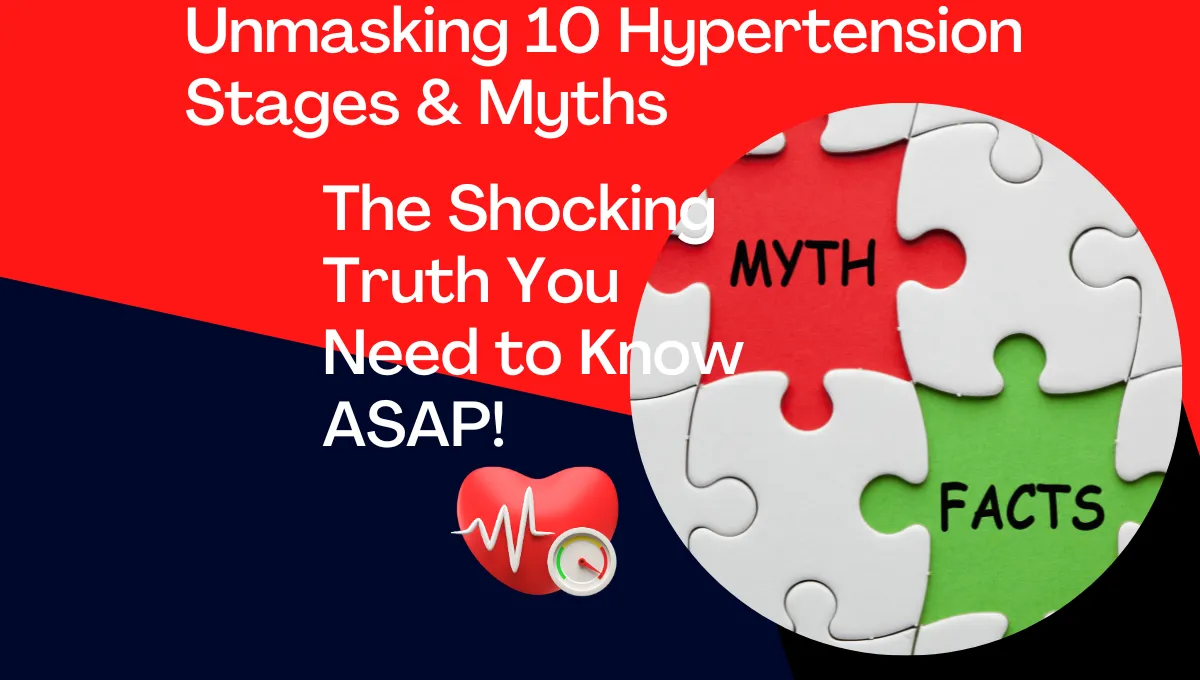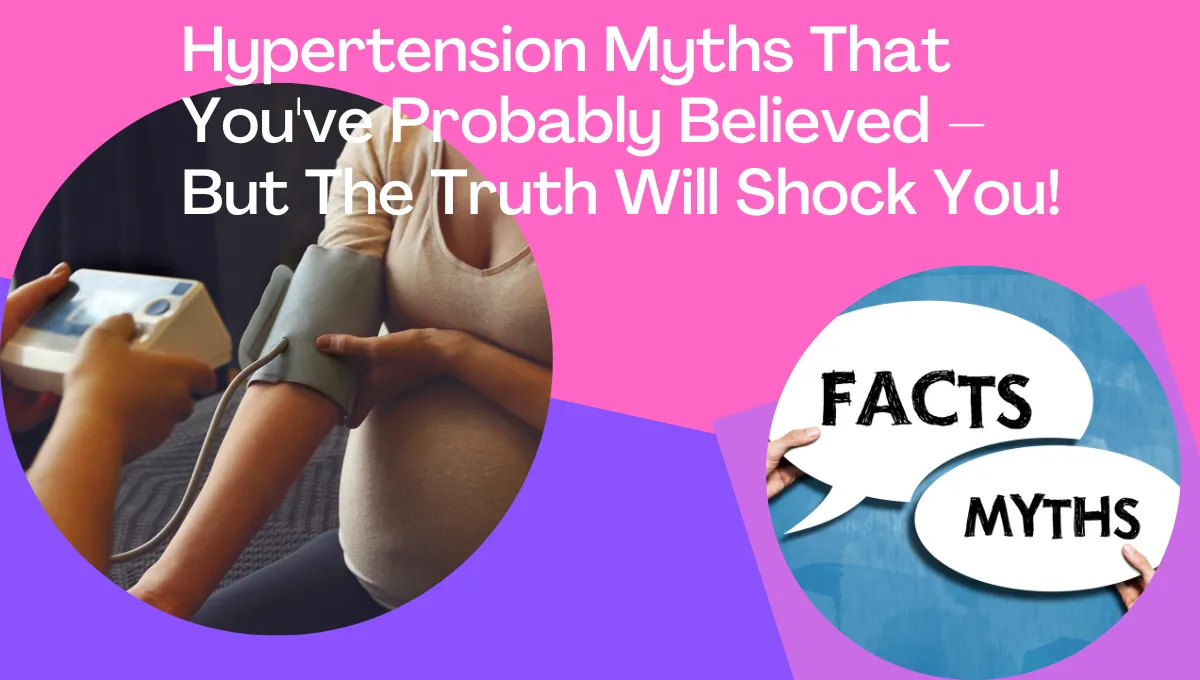- Unveiling the Hidden Risks: Understanding Hypertension Risk Factors
- Hypertension Stages
- 16 Hypertension Myths That You've Probably Believed – But The Truth Will Shock You!
- #1. The modern blood pressure cuff has been around for more than 100 years.
- # 2. The normal blood pressure range has changed.
- # 3. Most people with high blood pressure do not know they have it.
- # 4. Young people and pregnant women can have hypertension, too.
- # 5. Hypertension contributes to more than 1000 deaths per day.
- #6: Salt is the Only Thing That Affects Your Blood Pressure
- #7: Only Overweight or Obese People Develop Hypertension
- #8: Hypertension is a Men's Health Issue
- #9: You Can't Prevent Hypertension
- #10: Once You Have Hypertension, You'll Need Medication for Life
- #11: Exercise Makes Hypertension Worse
- #12: Hypertension is Just a Temporary Condition
- #13: There's Only One Way to Lower Your Blood Pressure
- #14:Hypertension Myths - Herbal Remedies Are a Cure
- #15:Hypertension Myths - Hypertension Is Inevitable with Age
- #16:Hypertension Myths - Cutting Out All Fats Lowers Blood Pressure
- 16 Hypertension Myths That You've Probably Believed – But The Truth Will Shock You!
- Holistic Approaches to Hypertension Prevention: Mind, Body, and Diet
Hypertension, also known as high blood pressure, is a common condition that affects millions of people around the world. Despite its prevalence, there are many myths and misconceptions about hypertension that can prevent people from taking the necessary steps to prevent or manage the condition. It is important to know the stages of hypertension because it helps in determining the appropriate treatment plan for the patient. There are different treatment guidelines for each stage of hypertension, and knowing the stage can help the doctor choose the most effective medication and dosage.
In this article, we will debunk 10 hypertension myths and reveal the truth behind them.
Hypertension Stages
Hypertension is classified into stages based on blood pressure readings. The following are the stages of hypertension based on the American Heart Association guidelines:
Normal blood pressure: Systolic blood pressure less than 120 mm Hg and diastolic blood pressure less than 80 mm Hg.
Elevated blood pressure: Systolic blood pressure between 120-129 mm Hg and diastolic blood pressure less than 80 mm Hg.
Stage 1 hypertension: Systolic blood pressure between 130-139 mm Hg or diastolic blood pressure between 80-89 mm Hg.
Stage 2 hypertension: Systolic blood pressure of 140 mm Hg or higher, or diastolic blood pressure of 90 mm Hg or higher.
It is important to note that hypertension can be asymptomatic, which means it may not present any symptoms. Therefore, regular blood pressure checks are essential for the early detection and management of hypertension.
16 Hypertension Myths That You’ve Probably Believed – But The Truth Will Shock You!
#1. The modern blood pressure cuff has been around for more than 100 years.
That’s right! For more than 100 years we’ve been measuring this vital health statistic the same way. Invented by Samuel Siegfried Karl Ritter von Basch in 1881, the modern blood pressure cuff, or sphygmomanometer, was popularized by Dr. Harvey Cushing in 1901. He brought the device to the US, modernized it, and popularized it within the medical community. We definitely think it’s time to move past the traditional cuff!
# 2. The normal blood pressure range has changed.
In 2017, The American Heart Association and American College of Cardiology redefined blood pressure guidelines, changing stage 1 levels from 140/90 to 130/80 mm Hg. At the time, the update meant that 30 million, or 14%, more American Adults officially had high blood pressure.
# 3. Most people with high blood pressure do not know they have it.
The biggest problem with hypertension – aka “the silent killer” – is there are no outward symptoms, making it difficult and inconvenient to regularly measure and thus preventing proper management. Of the 1.13 billion people worldwide who have hypertension, only half have it under control.
# 4. Young people and pregnant women can have hypertension, too.
While high blood pressure is very common in older people due to aging vascular systems, they are not the only age group at risk. Nearly 1 in 4 adults aged 20 to 44 in the US have high blood pressure, and according to the CDC, high blood pressure happens in 1 in every 12 to 17 pregnancies among women ages 20 to 44.
# 5. Hypertension contributes to more than 1000 deaths per day.
In the US, high blood pressure was a primary or contributing cause of death for more than 494,873 people in 2018. Having hypertension puts you at risk for heart disease and stroke, which are leading causes of death in the United States.
While there is no way to prevent primary hypertension, it can be controlled through a healthy lifestyle and medication if necessary, as advised by your doctor. Checking your blood pressure regularly is the only way to know for sure whether it is too high.
The World Health Organization estimates that 1.13Bn people worldwide have hypertension. Dubbed the “silent killer,” only one in five people afflicted with hypertension has control over their condition.
#6: Salt is the Only Thing That Affects Your Blood Pressure
While excessive salt intake can contribute to high blood pressure, it’s not the sole factor. Other lifestyle habits like smoking, alcohol consumption, lack of physical activity, stress, genetics, and underlying health conditions such as kidney disease can also play significant roles.
Adopting a balanced diet, maintaining a healthy weight, regular exercise, managing stress, and avoiding smoking and excessive alcohol can all help manage blood pressure levels.
#7: Only Overweight or Obese People Develop Hypertension
While being overweight or obese is a risk factor for hypertension, it’s not the only one. Hypertension can affect individuals of any weight, including those who appear thin. Factors like genetics, age, diet, physical activity level, and stress play significant roles.
Maintaining a healthy lifestyle with regular exercise, a balanced diet, stress management, and regular check-ups is essential for everyone, regardless of weight, to prevent and manage hypertension.
#8: Hypertension is a Men’s Health Issue
Hypertension affects both men and women, and women are not immune to its risks. However, women may face unique hypertension risk factors due to hormonal changes, such as pregnancy-related hypertension and menopause.
Additionally, women’s symptoms and responses to treatment may differ from men’s. Both men and women must monitor their blood pressure regularly, adopt healthy lifestyle habits, and seek medical advice when needed to prevent and manage hypertension effectively.
#9: You Can’t Prevent Hypertension
While some factors contributing to hypertension, such as genetics, cannot be changed, many lifestyle choices can help prevent or manage hypertension effectively.
Adopting a healthy lifestyle, including regular exercise, maintaining a balanced diet low in sodium, managing stress, limiting alcohol consumption, avoiding smoking, and maintaining a healthy weight, can all contribute to lowering blood pressure and reducing the risk of hypertension.
Regular check-ups and early intervention can also help identify and address risk factors before they develop into hypertension.
#10: Once You Have Hypertension, You’ll Need Medication for Life
While medication may be necessary to manage hypertension for some individuals, it’s not the only option, and lifestyle changes can often reduce or eliminate the need for medication.
Adopting a healthy lifestyle, including dietary changes, regular exercise, stress management, and avoiding tobacco and excessive alcohol use, can significantly impact blood pressure levels.
However, it’s essential to work closely with a healthcare provider to determine the most appropriate treatment plan based on individual health factors and monitor blood pressure regularly to ensure it remains within a healthy range.
#11: Exercise Makes Hypertension Worse
Regular exercise is a crucial component of managing hypertension and overall cardiovascular health. While short-term increases in blood pressure can occur during exercise, regular physical activity helps lower blood pressure in the long term by improving heart health, reducing stress, and promoting weight loss or maintenance.
However, individuals with hypertension should consult with their healthcare provider before starting an exercise program and choose activities appropriate for their fitness level and health status.
Gradual increases in exercise intensity and duration, along with proper warm-up and cool-down routines, can help minimize the risk of complications and maximize the benefits of exercise for hypertension management.
#12: Hypertension is Just a Temporary Condition
Hypertension, or high blood pressure, is not typically a temporary condition. While some factors, such as stress or certain medications, can cause temporary spikes in blood pressure, chronic hypertension is a long-term health concern that requires ongoing management.
If left untreated, hypertension can lead to serious complications such as heart disease, stroke, kidney damage, and vision loss.
It’s essential to address hypertension with lifestyle changes and, if necessary, medication under the guidance of a healthcare professional to prevent further health issues and improve overall well-being.
#13: There’s Only One Way to Lower Your Blood Pressure
Lowering blood pressure involves a multifaceted approach that goes beyond a single solution. While medication may be necessary for some individuals, lifestyle changes play a crucial role in managing hypertension effectively. Dietary modifications, such as reducing sodium intake, increasing potassium-rich foods, and following a heart-healthy diet like the DASH (Dietary Approaches to Stop Hypertension) diet, can significantly impact blood pressure levels.
Regular physical activity, stress management techniques like meditation or deep breathing exercises, maintaining a healthy weight, limiting alcohol consumption, and avoiding tobacco use are also important components of hypertension management.
The most effective approach to lowering blood pressure often involves a combination of these strategies tailored to individual health needs and preferences.
#14:Hypertension Myths – Herbal Remedies Are a Cure
While some herbs may help manage hypertension, they should not replace prescribed medications or lifestyle changes.
#15:Hypertension Myths – Hypertension Is Inevitable with Age
While age increases susceptibility, healthy lifestyle choices can mitigate the risk and delay or prevent the onset of hypertension.
#16:Hypertension Myths – Cutting Out All Fats Lowers Blood Pressure
While reducing unhealthy fats is beneficial, incorporating healthy fats like those from avocados and nuts can support heart health and lower blood pressure.
Holistic Approaches to Hypertension Prevention: Mind, Body, and Diet
Hypertension, commonly known as high blood pressure, affects millions of people worldwide and is a significant risk factor for heart disease, stroke, and other cardiovascular complications. While medication can be an essential part of managing hypertension, adopting holistic approaches that address the mind, body, and diet can also play a crucial role in prevention and treatment.
Here’s how incorporating holistic practices into your lifestyle can help lower blood pressure and improve overall cardiovascular health:
Mind: Stress Management and Relaxation Techniques
Chronic stress is closely linked to hypertension, as it can cause blood vessels to constrict and lead to elevated blood pressure levels. Incorporating stress management techniques such as mindfulness meditation, deep breathing exercises, yoga, and tai chi can help reduce stress and promote relaxation.
- These practices can help calm the nervous system, lower cortisol levels, and improve overall mental well-being, thereby contributing to better blood pressure control.
Body: Regular Physical Activity and Exercise
Regular physical activity is essential for maintaining cardiovascular health and preventing hypertension. Engaging in aerobic exercises such as brisk walking, jogging, cycling, swimming, or dancing can help strengthen the heart, improve circulation, and lower blood pressure.
- Aim for at least 150 minutes of moderate-intensity exercise or 75 minutes of vigorous-intensity exercise per week, spread out over several days. Additionally, incorporating strength training exercises can help build muscle mass, increase metabolism, and further support heart health.
Diet: Emphasizing Whole Foods and Nutrient-Rich Choices
Diet plays a crucial role in hypertension prevention and management. Following a heart-healthy diet that emphasizes whole foods, fruits, vegetables, lean proteins, and healthy fats can help lower blood pressure and reduce the risk of cardiovascular disease. The DASH (Dietary Approaches to Stop Hypertension) diet, in particular, has been shown to effectively lower blood pressure levels.
- Key components of the DASH diet include reducing sodium intake, increasing potassium-rich foods, moderating alcohol consumption, and limiting processed and high-fat foods.
Incorporating Holistic Practices into Daily Life
In addition to specific mind-body interventions and dietary changes, adopting holistic lifestyle practices can further support hypertension prevention and management.
- Prioritize getting an adequate amount of sleep each night, aiming for 7-9 hours of quality sleep to promote overall health and well-being.
- Stay hydrated by drinking plenty of water throughout the day, as dehydration can contribute to blood pressure fluctuations.
- Finally, cultivate healthy relationships, social connections, and a supportive community, as these factors can positively influence mental and emotional health, which in turn can impact blood pressure regulation.
Conclusion
By integrating holistic approaches that address the mind, body, and diet into your lifestyle, you can take proactive steps to prevent and manage hypertension. Remember to consult with a healthcare professional before making any significant changes to your lifestyle or treatment plan, and work collaboratively to develop a comprehensive approach that meets your individual needs and goals. With dedication and consistency, you can optimize your cardiovascular health and enjoy a fulfilling, active life.
Share this:
- Click to share on Facebook (Opens in new window) Facebook
- Click to share on Pinterest (Opens in new window) Pinterest
- Click to share on LinkedIn (Opens in new window) LinkedIn
- Click to share on X (Opens in new window) X
- Click to share on Tumblr (Opens in new window) Tumblr
- Click to share on Bluesky (Opens in new window) Bluesky



Did you know that thyroid disorders can contribute to hypertension?
Understanding the stages of hypertension is crucial for effective management. From prehypertension to stage 3, each stage requires different treatment approaches. This post provides valuable information on lifestyle changes, medication options, and regular check-ups. Thanks for sharing these essential tips!
Thank you for your sharing. Wow, this post really opened my eyes to the common myths surrounding hypertension! I had no idea that stress alone doesn’t directly cause high blood pressure. It’s great to have this kind of accurate information to share with others. Thanks for debunking these myths!
I’m trying to incorporate more heart-healthy foods into my diet. Any suggestions for quick and easy meal prep ideas?